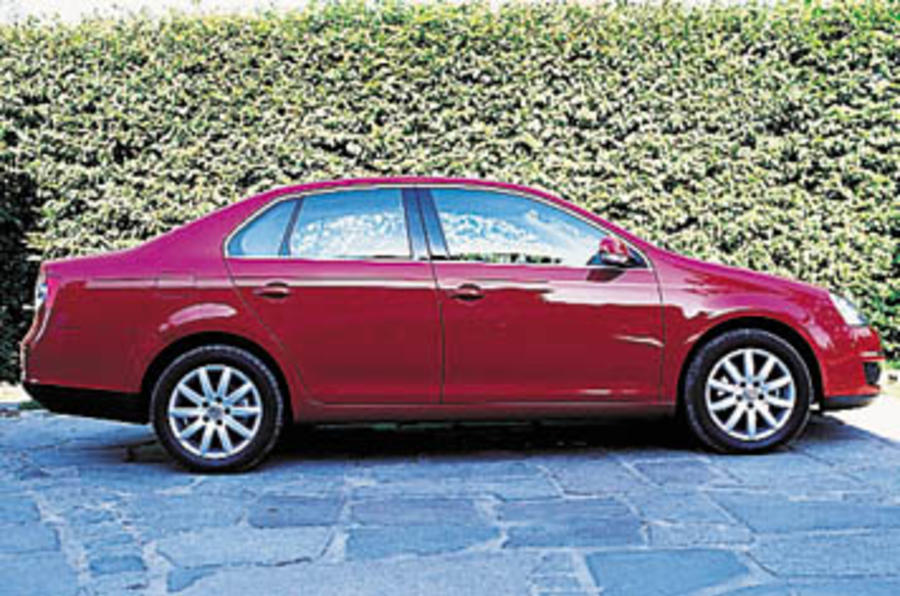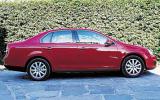The relationship between brothers can be a complicated one. You’re close but often there’s an undercurrent of competition, jealousy, and if you’re the younger sibling a secret desire to match your brother’s success. Which is exactly what we have here. Volkswagen launched the new Passat in January with it’s shiny new face and snazzy rear LED lights, and somewhere back at Wolfsburg a younger brother - the Golf-based saloon Bora - watched enviously as big brother got all the attention. So eight months later when the covers come off the new Bora, which reverts to the Jetta name of yore, it’s no surprise that it bears a striking similarity to the Passat. Around 6.6million Jettas/Boras have been sold since Volkswagen first started catering for the booted-hatch niche in 1979, with most finding homes in North America, and central Europe. In Britain, however, the concept found fewer fans; the MkIV Golf outselling the Bora by eight to one. Still, with Volkswagen aiming for 60,000 Golf sales next year, applying the same ratio infers 8,000 Jetta’s circulating the UK by the end of 2006. Not an insignificant model run, and just as important (volume-wise) for Volkswagen as the Toureg and Beetle. Despite what is essentially a Golf with a boot tacked on, and an elongated rear overhang, the Jetta looks remarkably different. The front inherits the Golf GTi’s grille and number plate surround, but where the GTi is menacing black, the Jetta opts for eye-catching, Passat emulating, chrome. Inside profile, from the B-pillar rearwards the Jetta uses different panels to the Golf, and the extra overall length - around 300mm - gives the car a stance from the segment above. In fact the Jetta is only 200mm shorter than the Passat. The similarity between the two saloon models is most obvious when viewed from the rear three-quarters - the shape of the C pillar and its intersection with the boot lid matching closely. Even the rear LED lights share a common design. But despite being a longer car, the Jetta shares the Golf’s wheelbase, meaning those extra 300mm do nothing for the cabin space, which shares the Golf’s just-enough rear legroom. Enough for two, but a struggle for three. Where the extra length counts is in the boot - 437 litres, 72 litres more than the outgoing Bora and only 40 less than the Passat. All models feature asymmetrically folding seats, and plusher models get a lockable load-through hatch. When the Jetta goes on sale in the UK next February, the initial engine options will be familiar; two Pumpe Duse choices - 1.9 (104bhp) or 2.0 (138bhp) and three petrol FSI variants - 1.6 (113bhp) or 2.0 (148bhp) and the 197bhp 2.0 Turbo from the Golf GTi, though it won't get the traditionally hatch-only badge. A 170bhp version of the 2.0TDI will follow later in the year. Trim options will follow VW UK’s standard hierarchy of S, SE and Sport. Although unlike the Golf, all models get electric windows front and rear and alloy wheels as standard. Pricing has yet to be confirmed but is expected to start at around £14,500 for the 1.6S. Other than some mild tweaks to the rear damping, the suspension, steering and brakes are carried straight over from the Golf. So no surprises that the driving experience is near identical, meaning an excellent compromise between ride quality and handling. The Mark V’s independent rear suspension gives the Golf/Jetta platform a level of precision and fluidity absent from previous generations. Surprisingly, VW claims the saloon and hatch have the same torsional stiffness; we’d have expected the Jetta to be stiffer, although there is no noticeable difference on the road. So the new Jetta uses the excellent Golf as a base, adds some useful extra space and a few more toys and is anticipated to cost only a few more notes more than Golf. Sounds like a good proposition. And it is, but the real difference with new Jetta is the way the car looks. No longer does the booted Golf look slightly short-arsed and rather inadequate, instead there’s a proper flow to the design. As the Passat has grown, now almost qualifying as a full size executive saloon, the Jetta has eagerly nipped into the space left behind. But does VW need two models, looking so similar and essentially occupying the same area of the market? Passat offers more cabin space and a slightly better finish; Jetta provides the marginally better drive. On price grounds there is not much space between the Golf and Passat as it is - for the same engine the gap is £1000 at its narrowest (for the 1.9tdi) broadening to £2,000 for the 2.0TDI 140ps Sport. Assuming the Jetta fits between these two, the price difference between the two saloons is going to be mighty close. Expect some fierce sibling rivalry in the showrooms.Jamie Corstorphine
Strong design builds on excellent Golf basics. A slightly smaller Passat for slightly less money. Is there a market for both?
Close
Back to top


















Add your comment